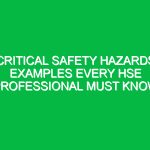Introduction
In today’s fast-paced business Environment, the concept of Safety for companies has evolved beyond mere compliance; it is now a cornerstone of operational excellence. Safety for companies, particularly within the Health, Safety, and Environment (HSE) domain, encompasses a comprehensive approach to protecting employees, assets, and the environment. It involves identifying potential Hazards, implementing preventative measures, and fostering a culture of Safety that permeates all levels of the organization. In this article, we will explore essential Safety Strategies that companies can adopt to ensure the well-being of their workforce while minimizing risks and enhancing productivity.
Understanding Safety for Companies in the HSE Context
Safety for companies is not just about following Regulations; it is about creating an environment where employees feel secure and valued. A strong safety culture promotes trust and encourages open communication about safety concerns. Moreover, when employees believe their health and safety are prioritized, they are more likely to be engaged and productive.
In the context of HSE, safety management involves several key components, including risk assessment, training, incident reporting, and continuous improvement. Each of these elements contributes to a robust safety framework that can adapt to the ever-changing landscape of workplace risks.
Key Components of Safety for Companies
1. Risk Assessment
Risk assessment is the foundation of any effective safety strategy. This process involves identifying potential Hazards in the workplace, evaluating the risks associated with those hazards, and implementing measures to mitigate or eliminate them. A thorough risk assessment should involve:
- Identifying Hazards: Conduct regular inspections and engage employees to identify potential hazards.
- Evaluating Risks: Analyze the likelihood and potential impact of each identified hazard.
- Implementing Controls: Develop and enforce policies and Procedures to control or eliminate risks.
For instance, a manufacturing company identified that employees were at risk of repetitive strain injuries due to their workstations. By conducting a risk assessment, they were able to redesign workstations to promote ergonomic practices, thereby reducing the incidence of injuries.
2. Training and Education
Training is essential for empowering employees to recognize and respond to hazards effectively. Companies should develop a comprehensive Training program that covers:
- General safety policies and procedures
- Job-specific safety protocols
- Emergency response procedures
- First aid and CPR training
Regular refresher courses and hands-on training can reinforce safety practices and keep safety at the forefront of employees’ minds. For example, a construction firm that implemented quarterly safety training sessions saw a significant reduction in accidents on-site, demonstrating the positive impact of ongoing education.
3. Incident Reporting and Investigation
An effective safety culture encourages employees to report incidents, near misses, and safety concerns without fear of retribution. Creating a non-punitive reporting system allows management to gather valuable insights into potential safety issues. The process typically includes:
- Establishing clear reporting channels
- Encouraging prompt reporting of incidents
- Conducting thorough investigations to identify root causes
- Implementing corrective actions to prevent recurrence
A healthcare organization that adopted a robust incident reporting system was able to reduce medication errors significantly. By encouraging staff to report near misses, they gained insights that led to improved protocols and training.
4. Continuous Improvement
Safety for companies is not a one-time effort; it requires ongoing evaluation and improvement. Businesses should regularly review their safety policies and practices to adapt to changes in the work environment, technology, and regulations. Continuous improvement can be achieved through:
- Regular safety audits and inspections
- Employee feedback and suggestions
- Staying updated on industry Best Practices
For instance, a logistics company that instituted bi-annual safety audits discovered several outdated practices that posed risks to employees. By updating their protocols based on audit findings, they improved Workplace Safety significantly.
Potential Hazards and Risks
Understanding the specific hazards associated with different industries is crucial for effective safety management. Common hazards include:
- Physical Hazards: These include slips, trips, falls, and machinery-related incidents.
- Chemical Hazards: Exposure to harmful substances can lead to serious health issues.
- Biological Hazards: This includes exposure to bacteria, viruses, and other pathogens.
- Ergonomic Hazards: Poor workstation design can result in musculoskeletal disorders.
Each industry may have unique risks, and understanding these can help tailor safety strategies to address specific challenges.
Best Practices for Enhancing Safety for Companies
Implementing Best Practices in safety management can significantly enhance a company’s safety culture. Here are some actionable strategies:
1. Foster Open Communication
Encouraging employees to voice their safety concerns creates a culture of transparency. Regular safety meetings and open-door policies can facilitate communication. Employees should feel comfortable reporting unsafe conditions without fear of negative repercussions.
2. Promote Employee Engagement
Engaged employees are more likely to take safety seriously. Involve employees in safety committees or initiatives, allowing them to contribute to developing safety protocols. This sense of ownership can lead to increased awareness and adherence to safety practices.
3. Utilize Technology
Leverage technology to enhance Safety Measures. This can include implementing safety management software, using wearable technology to monitor employee health and safety, or incorporating virtual reality training programs to simulate hazardous scenarios. Technology can provide innovative solutions to traditional safety challenges.
4. Recognize and Reward Safe Behavior
Recognition programs can motivate employees to prioritize safety. Consider implementing rewards for teams or individuals who demonstrate exceptional safety practices. This acknowledgment reinforces the importance of safety and encourages others to follow suit.
Regulations and Standards Governing Safety for Companies
Understanding the legal framework surrounding safety for companies is essential for compliance and effective safety management. Various regulations and standards exist to guide organizations in implementing Safe Practices. Key regulations include:
- Occupational Safety and Health Administration (OSHA): osha sets standards to ensure safe working conditions in the United States. Compliance with OSHA regulations is mandatory, and violations can result in severe penalties.
- International Organization for Standardization (ISO): The ISO 45001 standard provides a framework for Occupational Health and safety management systems. Adopting this standard can enhance an organization’s safety practices and demonstrate a commitment to employee well-being.
- Environmental Protection Agency (EPA): The EPA regulates Environmental Safety and pollution Prevention. Companies must comply with EPA regulations to ensure Safe Practices that protect both employees and the environment.
Understanding these regulations helps companies maintain compliance while fostering a culture of safety.
Conclusion
Safety for companies is an integral aspect of the Health, Safety, and Environment (HSE) domain. By implementing essential safety strategies, organizations can protect their workforce, reduce risks, and promote a culture of safety that enhances productivity and employee morale. The importance of safety cannot be overstated; it is not just a regulatory requirement, but a fundamental component of a thriving workplace.
As we navigate the complexities of modern business, companies must remain vigilant in their commitment to safety. By prioritizing safety for their workforce and continuously improving practices, organizations can create an environment where employees feel secure, valued, and empowered to thrive. Now is the time for companies to reflect on their safety strategies and take actionable steps to protect their greatest asset—their workforce.


